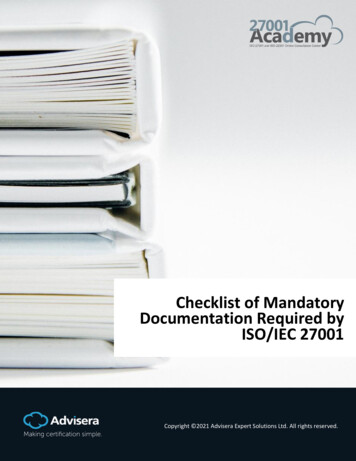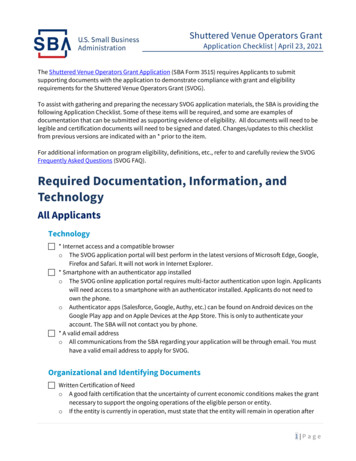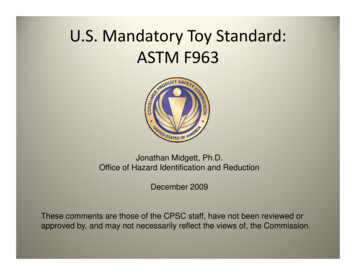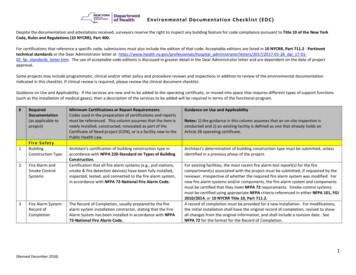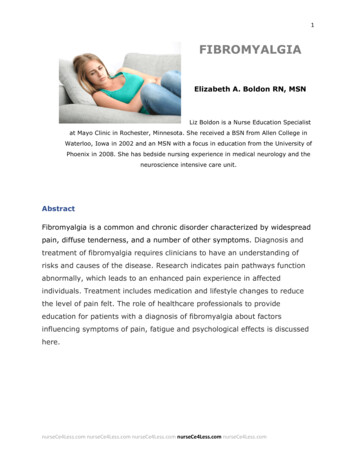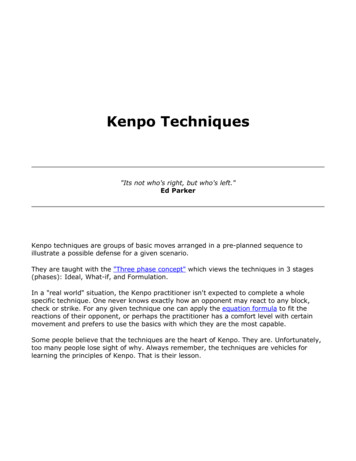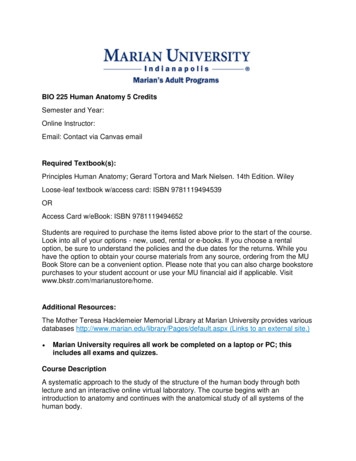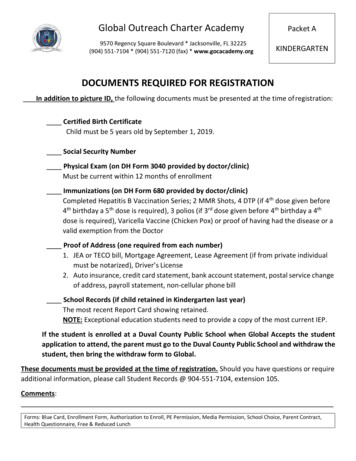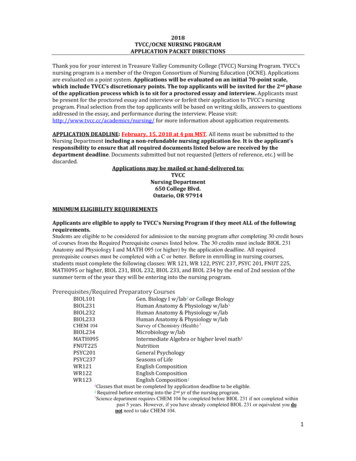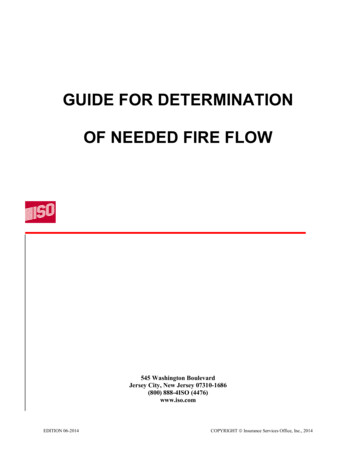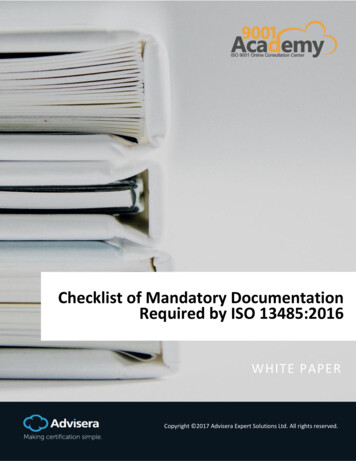
Transcription
Checklist of Mandatory DocumentationRequired by ISO 13485:2016WHITE PAPERCopyright 2017 Advisera Expert Solutions Ltd. All rights reserved.Copyright 2017 Advisera Expert Solutions Ltd. All rights reserved.1
Table of ContentsExecutive summary . 3Introduction . 3Which documents and records are required? . 4Mandatory documents . 4Mandatory records . 6Commonly used non-mandatory documents . 8How to structure documents and records. 9Conclusion. 16Sample documentation templates . 16References . 17Copyright 2017 Advisera Expert Solutions Ltd. All rights reserved.2
Executive summaryThe latest version of ISO 13485 was published in 2016, and the transition from the previous version isahead. One of the most important steps in the transition process, as well as in the initial implementation,is determining what documents and records are needed for an effective Quality Management System(QMS) based on ISO 13485. This white paper is designed to help top management and employees involvedin ISO 13485 implementation or transition, and to clear up any misunderstandings regarding documentsrequired by the standard.In this document, you will find an explanation of which documents are mandatory according to the ISO13485:2016 standard, and which non-mandatory documents are commonly used in the QMSimplementation, in the same order and numbered clauses as in ISO 13485.IntroductionThe documentation needed for implementation of ISO 13485 includes any documents explicitly requiredby the standard, plus any additional documents that the company determines to be necessary foreffective maintenance of the QMS based on ISO 13485. Many companies go overboard withdocumentation in the belief that they need to document every single process that is in place in theirorganization, without realizing that this is not necessary to meet the requirements of the ISO 13485standard. While trying to fulfill standard requirements, organizations tend to generate too manydocuments to be on the “safe side.”Although it is sometimes helpful, this can be counterproductive, because it makes the implementedprocesses and respective QMS harder to use and maintain, as well as making the QMS a bureaucraticburden. With this approach, organizations miss opportunities to improve their processes for their ownbenefit, as well as that of their customers.In this whitepaper, you will find, explained in plain English, what the minimum ISO 13485 requirementsfor the documentation are, as well as a list of documents that are commonly in place and can help youmake your QMS more efficient.Copyright 2017 Advisera Expert Solutions Ltd. All rights reserved.3
Which documents and records arerequired?Mandatory documentsMandatory documentClause of ISO13485:2016Document the role(s) undertaken by the organization4.1.1Written quality agreements with outsource partners4.1.5Procedure for the validation of the application of computersoftware4.1.6, 7.5.6, 7.6Quality manual4.2.1Quality policy4.2.1Quality objectives4.2.1Procedure for document control4.2.4Procedure for record control4.2.5Responsibilities and authorities5.5.1Procedure for management review5.6.1Procedure for competence, training and awareness6.2Requirements for the infrastructure6.3Requirements for the maintenance activities6.3Requirements for the work environment6.4.1Procedure to monitor and control the work environment6.4.1Requirements for health, cleanliness and clothing of personnel6.4.1Arrangements for the control of contaminated or potentiallycontaminated product6.4.2Requirements for control of sterile medical device contamination6.4.2Processes for risk management in product realizationArrangements for communicating with customersCopyright 2017 Advisera Expert Solutions Ltd. All rights reserved.7.17.2.34
Mandatory documentClause of ISO13485:2016Procedure for design and development7.3.1Procedure for purchasing7.4.1Procedure and methods for the control of production7.5.1Requirements for cleanliness of product7.5.2Requirements for medical device installation and acceptance criteriafor verification of installation7.5.3Procedure for servicing activities of medical devices7.5.4Procedures for validation of processes7.5.6Procedure for the validation of processes for sterilization7.5.7Procedure for product identification7.5.8Procedure for traceability7.5.9.1Procedure for preserving the conformity of product7.5.11Procedure for monitoring and measuring equipment7.6Procedure for customer feedback gathering8.2.1Procedure for complaint handling8.2.2Procedure for internal audit8.2.4Procedure for control of nonconforming product8.3.1Procedure for issuing advisory notices8.3.3Procedure for rework8.3.4Procedure for analysis of data8.4Procedure for corrective actions8.5.2Procedure for preventive actions8.5.3Copyright 2017 Advisera Expert Solutions Ltd. All rights reserved.5
Mandatory recordsMandatory recordRecords of software validation activitiesClause of ISO13485:20164.1.6, 7.6Medical device file4.2.3Records of management review5.6.1Records of education, training, skills and experience6.2Records of the maintenance activities6.3Records of risk management activities7.1Outputs of product realization planning7.1Records of the results and actions arising from review of requirementsrelated to product7.2.2Records of product requirements changes7.2.2Design and development planning documents7.3.2Design and development inputs7.3.3Design and development outputs7.3.4Records of design and development review7.3.5Records of the results and conclusions of the design and developmentverification7.3.6Design and development validation plans7.3.7Records of the results and conclusion of design and developmentvalidation7.3.7Results and conclusions of the design and development transfer7.3.8Records of design and development changes7.3.9Design and development file7.3.10Records of the results of evaluation, selection, monitoring and reevaluation of supplier7.4.1Records of the purchased product verification7.4.3Record for each medical device or batch of medical devices7.5.1Records of medical device installation and verification of installation7.5.3Copyright 2017 Advisera Expert Solutions Ltd. All rights reserved.6
Mandatory recordClause of ISO13485:2016Records of servicing activities7.5.4Records of the sterilization process parameters7.5.5Records of the results and conclusion of validation7.5.6Records of the results and conclusion of sterile medical device validation7.5.7Records of traceability7.5.9.2Records of the name and address of the shipping package consignee7.5.9.2Report to the customer about changes on his property7.5.10Records of the results of calibration and verification of monitoring andmeasuring equipment7.6Customer feedback report8.2.1Complaint handling records8.2.2Records of reporting to regulatory authorities8.2.3Internal audit plan8.2.4Internal audit report8.2.4Evidence of conformity of products with the acceptance criteria8.2.6Identity of the person authorizing release of product8.2.6Identity of personnel performing any inspection or testing of implantablemedical devices8.2.6Record of nonconformity8.3.1Records of the product acceptance by concession and the identity of theperson authorizing the concession8.3.2Records of actions relating to the issuance of advisory notices8.3.3Records of rework8.3.4Records of the results of data analyses8.4Records of corrective actions8.5.2Records of preventive actions8.5.3These are the documents and records that are required to be maintained for the ISO 13485 QualityManagement System, but you should also maintain any other records that you have identified asnecessary to ensure your management system can function, be maintained, and improve over time.Copyright 2017 Advisera Expert Solutions Ltd. All rights reserved.7
Commonly used non-mandatorydocumentsISO 13485 does not require that you document all of the procedures, but there are a lot of mandatoryprocesses that must be established in order to generate the required records that are outlined in the firstsection. Unlike ISO 9001, which leaves a lot of freedom in deciding whether to document a procedure ornot, ISO 13485 doesn’t leave much room for different interpretations, and basically, all major proceduresmust be documented. In the table below, you can find examples of the documents that are not requiredby the standard, but can be beneficial to the QMS:Document titleClause of ISO13485:2016Procedure for measuring customer satisfaction5.2Procedure for identification of regulatory and customer requirements5.2Procedure for internal communication5.5.3Procedure for planning product realization7.1Quality plan7.1Sales procedure7.2One rule of thumb when deciding if you want to document a process is this: if there is a chance that theprocess won’t be carried out as planned, then you should document it. In many cases, this is the best wayto ensure that your Quality Management System is implemented reliably.Copyright 2017 Advisera Expert Solutions Ltd. All rights reserved.8
How to structure documents and recordsISO 13485 has a lot of requirements regarding documentation, so it is imperative that you optimize thevolume of your QMS documentation by trying to develop documentation that meets all requirements,while remaining simple and light. Although there are requirements for more than 20 procedures, manyof them can be merged together, and this approach can provide you with a smaller number of documents.This is especially important for the small and midsize companies that want to implement the standard.The general advice is to identify common requirements or requirements that relate to the same elementof your QMS, and try to merge documented procedures.The following recommendations take into consideration the best practice in developing QMSdocumentation:Document the role(s) undertaken by the organization. The organization needs to document its roles inthe market under the applicable regulatory requirements. Those roles can be manufacturer, authorizedrepresentative, importer, or distributor. The roles of the company are rarely documented as a separatedocument; they are usually documented in the Quality Manual.Written quality agreements with outsource partners. When the organization chooses to outsource anyprocess that affects product conformity with requirements, it shall monitor and ensure control over suchprocesses, because it retains responsibility for conformity of the product to customer and regulatoryrequirements. These arrangements can include the requirements for products, processes, and services,and are usually defined in the contract or the Procedure for Purchasing and Evaluation of Suppliers.Procedure for the validation of the application of computer software. When the computer software isused in Quality Management System, the organization needs to validate it prior to initial use and afterthe changes to the software or its application. Requirements and description of the validation activities,together with the resulting records are defined in the Procedure for Documentation and Validation ofComputer Software.Quality manual. This is a roof document for your QMS, and it usually includes the QMS scope, role(s)undertaken by the organization, exclusions from the standard, references to relevant documents, and thebusiness process model. For more information on how to write the Quality Manual, see: Writing a shortQuality Manual. The article explains ISO 9001 requirements but it is also applicable to ISO 13485.Quality policy. A policy represents a declarative statement by an organization. A Quality Policy shouldstate the commitment of the organization to quality and continual improvement, and provide aframework for setting quality objectives. For more information on how to write a Quality Policy, see: Howto Write a Good Quality Policy, the article explains ISO 9001 requirements but it is also applicable to ISO13485.Copyright 2017 Advisera Expert Solutions Ltd. All rights reserved.9
Quality objectives. These are derived from the goal stated in the Quality Policy, and are the main methodused by companies to focus this goal into plans for improvement. The objectives are intended to beS.M.A.R.T. (specific, measurable, achievable, realistic, and time-based), and should have relevance at alllevels of the company, meaning that all employees should understand how their jobs support meetingthe Quality Objectives. The article How to Write good Quality Objectives gives more information on thisprocess. The article explains ISO 9001 requirements but it is also applicable to ISO 13485.Procedure for document control. This document defines how you approve, update, and re-approve yourdocuments. When a document is changed, how do you identify changes, and make sure that people whoneed the current document have it and stop using older documents? How do you make sure thedocuments can be read and how do you control documents that come from outside of your organizationfor use? Find out more about documentation with Some Tips to make Document Control more useful foryour QMS. The article explains ISO 9001 requirements but it is also applicable to ISO 13485.Procedure for record control. How do you maintain your records that show your product is acceptablefor use, including how you identify, store, and protect the records so that they can be retrieved asnecessary, for the correct amount of time, and destroyed when no longer needed – but not before? Inorder to make the documentation more efficient, this procedure is commonly merged with the procedurefor document control. Here you can find free preview of the Procedure for Document and Record Control.Responsibilities and authorities. The standard requires responsibilities and authorities within the QMSto be defined, communicated and documented. This can be done in two ways, the organization can havea separate document that contains information about all roles and responsibilities or it can document theroles and responsibilities within the documents that describe processes and activities, e.g. proceduresand work instructions.Management review. How do you conduct your review of the system to ensure that all areas of thesystem are functioning, and that improvements are happening where planned and expected? How do youcontrol the flow of information on management decisions out to the company? Learn more in this articleabout How to make Management Review more practical. The article explains ISO 9001 requirements, butit is also applicable to ISO 13485.Procedure for competence, training and awareness. This procedure should describe how the process ofidentification and achieving necessary competence is performed, as well as how the company raisesawareness of its employees regarding the QMS. For more information about the training and awareness,see: Improving quality through effective training and ISO 9001 awareness training material: How to createit, what it should contain. Both of the articles explain ISO 9001 requirements, but they are also applicableto ISO 13485.Requirements for infrastructure. The standard requires the organization to define and documentrequirements for infrastructure needed to achieve conformity to product requirements, prevent productmix-up and ensure orderly handling of product.Copyright 2017 Advisera Expert Solutions Ltd. All rights reserved.10
Requirements for maintenance activities. In cases when the maintenance activities can affect theproduct quality, the organization needs to document those requirements. This document defines whatmaintenance activities need to be performed and the interval of the activities. Instead of being astandalone document, it can be merged with the Procedure for Infrastructure and Work Environment.Requirements for work environment and procedure for monitoring and controlling the workenvironment. When conditions for the work environment can have an adverse effect on product quality,the organization needs to document the requirements for the work environment and the procedures tomonitor and control the work environment.Requirements for health, cleanliness and clothing of personnel. If contact between personnel and theproduct or work environment could affect medical device safety or performance, the organization needsto document requirements for health, cleanliness, and clothing of personnel.Arrangements for the control of contaminated or potentially contaminated product. In order to preventcontamination of the work environment, personnel, or product, the organization needs to plan anddocument arrangements for the control of contaminated or potentially contaminated product. Fororganizations that aim to decrease the number of documents in their QMS, requirements forinfrastructure, maintenance, and work environment can be merged into a single procedure. Here you canfind a free preview of the Procedure for Infrastructure and Work Environment.Procedure for sterile medical devices. For sterile medical devices, the organization must documentrequirements for control of contamination with microorganisms or particulate matter and maintain therequired cleanliness during assembly or packaging processes.Procedure for risk management. Part of the planning of product realization is assessment of risks thatcan result in noncompliance with the requirements for product or processes of the Quality ManagementSystem. The organization needs to document one or more processes for risk management for productrealization.Arrangements for communicating with customers. The organization must document arrangements forcommunicating with customers in relation to product information, inquiries, contracts, or order handling,including amendments, customer feedback and complaints, and advisory notices. These requirements areoften merged with the Sales Procedure.Procedure for design and development. Requirements regarding the design and development processare among the most demanding in the standard. Every step of the design and development process needsto be documented in the form of a record, from design and development inputs, controls, and outputs,to changes in design and development. Considering all the requirements regarding the design anddevelopment process, it is best to document the Procedure for Design and Development and define allmandatory records that should accompany the procedure.Procedure for purchasing. The standard requires companies to establish control over their externallyprovided processes, products, and services. Documenting the criteria for evaluation, selection,Copyright 2017 Advisera Expert Solutions Ltd. All rights reserved.11
monitoring, and reevaluation of the suppliers will enable an organization to ensure that purchasedproduct conforms to specified purchasing information. For more information about the purchasingprocess, see Purchasing in QMS – The Process & the Information Needed to Make it Work. The articleexplains ISO 9001 requirements, but it is also applicable to ISO 13485.Procedure for production. The standard requires production and service provision processes to be undercontrol in terms of availability of necessary documented information about product or servicecharacteristics, intended results, availability of needed resources, monitoring and measurementactivities, etc. This rather complex process will hardly achieve the intended outcomes without clearlydefined rules documented in the Procedure for Production and Service Provision.Requirements for cleanliness of product. The organization needs to define requirements for cleanlinessof product or contamination of product in cases when product is cleaned by the organization prior tosterilization or its use, the product cleanliness is significant in use, and process agents are to be removedfrom product during manufacture. This can be documented either separately, or with the Procedure forProduction and Service Provision, or in some other appropriate document.Procedure for medical device installation. Requirements for medical device installation and acceptancecriteria for verification of installation need to be documented, and the records of the installation andverification activities need to be maintained. This can be a stand-alone procedure, or it can be a part ofthe Procedure for Production and Service Provision.Procedure for servicing activities of medical devices. In cases when the servicing activities are required,the organization needs to document the servicing procedure, as well as reference materials andmeasurements if they are necessary for performing the servicing activity. Organizations with complexservicing activities will document the procedure as a separate document, but those with a simplerservicing process can include this procedure in the Procedure for Production and Service Provision.Procedure for validation of processes. When the resulting output of the production and service provisionprocess cannot be verified by subsequent monitoring and measuring, the organization needs to validatesuch processes and document the procedure for validation. This procedure also offers the possibility tobe merged with the Procedure for Production and Service Provision in cases of simpler validationactivities.Procedure for validation of the sterilization process. Organizations that perform sterilization and havesterile barrier systems need to validate the process prior to implementation, and this procedure forsterilization needs to be documented. Depending on the complexity of processes, this procedure can bemerged with the Procedure for Sterile Medical Devices.Procedure for product identification. The product must be identified through processes of production,storage, installation, and servicing of product to ensure that only product that has passed the requiredinspections and tests is used or installed. The procedure for identification of the product must bedocumented and, again, in cases of less complex processes, the procedure can be merged with theProcedure for Production and Service Provision.Copyright 2017 Advisera Expert Solutions Ltd. All rights reserved.12
Procedure for traceability. The organization needs to define the extent of traceability in accordance withapplicable regulatory requirements and to document the procedure for traceability. Depending on thecomplexity of the traceability activities, the procedure can be merged with the Procedure for Productionand Service Provision.Procedure for preservation of product conformity. The organization must protect product fromalteration, contamination, or damage during processing, storage, handling, and distribution, and this canbe achieved through a documented procedure for preservation of product. These requirements areusually documented in the Warehousing Procedure and in procedures defining each of the abovementioned processes.Procedure for monitoring and measuring equipment. The purpose of the monitoring and measuring isto provide evidence of conformity of product to determined requirements. In order to ensure thatmonitoring and measuring can be carried out and is carried out properly, the organization needs todocument a Procedure for Equipment Maintenance and Measurement Equipment.Procedure for gathering customer feedback. ISO 13485 emphasizes customer feedback over customersatisfaction. As one of the measurements of the effectiveness of the QMS, the organization needs togather and monitor information relating to whether the organization has met customer requirements,and document the methods for obtaining and using this information. Because the sales process is mostcommonly in contact with the customers, this procedure is often merged with the Sales Procedure.Procedure for complaint handling. Considering the possible impact some medical devices can have onthe quality of life of customers, there is a requirement to document how the complaint-handling processwill be carried out. Again, very often, the sales process is the first in line when it comes to contact withcustomers, so it can be useful to document the complaint-handling process as a part of the SalesProcedure.Procedure for internal audit. The internal audit is the process that determines whether the QMS isperforming as planned, and if it is effective. The most important information regarding the internal audit,including responsibility for planning, method of conducting and reporting, and the follow-up activities,needs to be documented in the Procedure for Internal Audit.Procedure for control of nonconforming product. This procedure needs to provide answers to thefollowing questions: What controls are in place, and who is responsible, to make sure that nonconforming product is not used? Are there terms that can be put in place to allow the use ofnonconforming product such as Rework, Repair, or Acceptance by the Customer? How do you ensure thatcorrected product is re-verified, and what records are kept of the process? Learn about the Five Steps forISO 9001 Nonconforming Products here. The article explains ISO 9001 requirements, but it is alsoapplicable to ISO 13485.Procedure for issuing advisory notices. In cases when the nonconforming product is discovered afterdelivery or use has started, the organization must not only take action to resolve the nonconformity, butalso issue advisory notices to customers. The procedure for issuing advisory notices must be aligned withCopyright 2017 Advisera Expert Solutions Ltd. All rights reserved.13
relevant legislation, and documented. Because this is a part of communications with customers, thisprocedure can be merged with the Procedure for Customer Communication, Feedback and Complaints.Procedure for rework. The rework needs to be done in a way that takes into account the potential adverseeffects of the rework on the product. The procedure for rework needs to be documented and undergosame review and approval as the Procedure for Production and Service Provision so it is reasonable tomerge these two procedures to decrease the amount of documentation in small and mid-size companies.Procedure for analysis of data. The organization needs to determine, collect, and analyze appropriatedata to demonstrate the suitability, adequacy, and effectiveness of the QMS and to document how dataanalysis process is conducted. The Procedure for Data Analysis defines how the data are gathered andprocessed.Procedure for corrective action. The procedure for reviewing nonconformities, determining the causes,and implementing and evaluating necessary actions needs to be documented. To learn more about thecorrective action process, see: Seven Steps for Corrective and Preventive Actions to support ContinualImprovement. The article explains ISO 9001 requirements, but it is also applicable to ISO 13485.Procedure for preventive action. How can you handle a nonconformity before it occurs? Preventiveactions are used to address such situations, and because the method of conducting the preventive actionsis not so different from the corrective action, it is common to merge those two procedures into oneProcedure for Corrective and Preventive Action.As a minimum, these are the documented procedures that are necessary to meet the requirements, andall that is needed to document a simple QMS. However, there is often a need to provide writtendocuments for more, and the trick is in knowing what else your company needs to document. If you areimplementing a Quality Management System, you may struggle with the decision of what needs to bewritten down. This is common, but wisely answering the question: “What should I document?” can avoidcomplexity in your Quality Management System, saving time and money. The following are the mostcommonly used non-mandatory documents with the purpose of enhancing the QMS and decreasing thechance of nonconformity occurrence.Procedure for measuring customer satisfaction. Although ISO 13485 does not require an organization tomonitor customer satisfaction, it is very common for organizations to have such a process in addition tothe customer feedback gathering requirements. A customer satisfaction survey allows an organization tofind out more about the needs and expectations of its customers, and understand how they perceive theorganization, and these can be valuable inputs for improvement of the QMS. For more information, see:Main elements of handling customer satisfaction in ISO 9001. The article explains ISO 9001 requirements,but it is also applicable to ISO 13485.Procedure for identification of regulatory and customer requirements. The medical device industry ishighly regulated, and failure to comply with the regulations can have a high price for the company.Documenting the manner in which the regulatory and customer requirements are identified and met,
(QMS) based on ISO 13485. This white paper is designed to help top management and employees involved in ISO 13485 implementation or transition, and to clear up any misunderstandings regarding documents required by the standard. In this document, you will find an explanation of which docu
